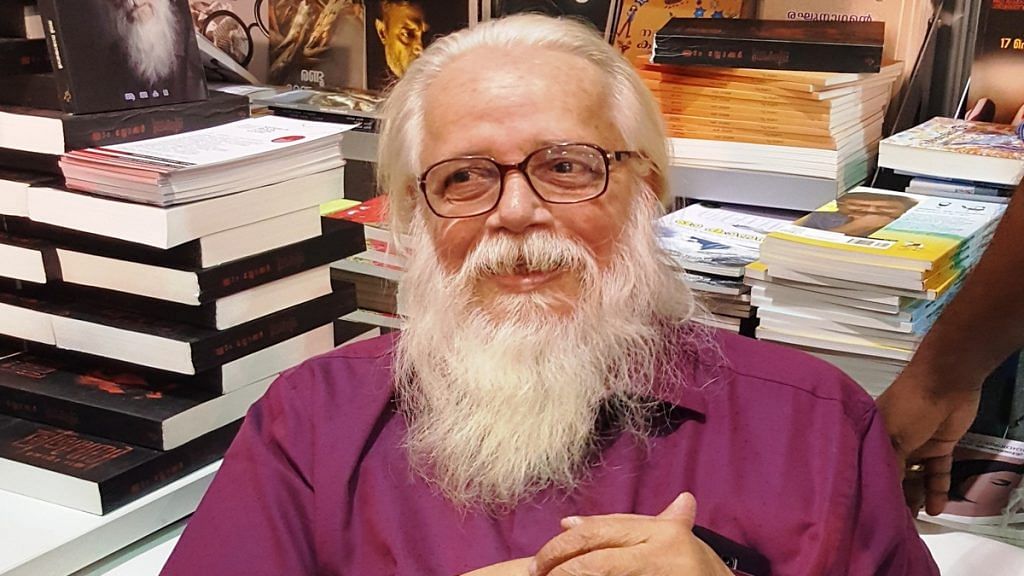New Delhi: Former Indian Space Research Organisation (ISRO) scientist Nambi Narayanan, wrongly implicated in a fake spying case, has received a compensation of Rs 1.3 crore from the Kerala government. But the money cannot restore the scientist’s “lost image, career and lifelong scientific work”, said ThePrint’s Editor in Chief, Shekhar Gupta, who investigated and exposed the case as fake in 1995.
In episode 548 of Cut The Clutter from Delhi’s 13th century Chor Minar, Gupta elaborated on the spying case, viciously concocted by the Intelligence Bureau and the state police, dirty politics in Kerala, and Narayanan’s decades-long fight for justice.
Gupta called the case a “spy non-scandal” and “a great intelligence and public opinion scandal”, and added that the ones found guilty were not Narayanan and fellow ISRO scientist D. Sasikumaran, who had been accused, but policemen and IB officers who conjured up a completely fictional story, in turn doing damage to India. They were the people who should have been punished, but were not, Gupta said.
According to Gupta, the scientists were not only arrested as “traitors” for a case with no evidence, but they were also treated badly in custody and faced enormous public opprobrium, particularly in the Kerala press.
“They were pronounced as Pakistanis pies, selling away India’s most important secrets… Secrets about the cryogenic engines which were going to power India’s GSLV,” he said.
It was alleged that Nambi Narayanan and Sasikumaran were doing this because they had been ‘honey trapped’ and bribed by two Maldivian women, Mariam Rasheeda and Fauzia Hassan.
Also read: ISRO scientist Nambi Narayanan says Kalam wanted him to give up fight, but he refused
The ‘spy’ case
The general plot of the ‘spy case’ involved six ‘conspirators’ — the two scientists, the two Maldivian women, and a man called K. Chandrasekharan.
According to the police, these five conspirators met in Madras International Hotel in what is now Chennai, along with a DIG of Kerala Police, Raman Srivastava, and hatched a conspiracy to sell India’s ‘scientific secrets’.
It was also alleged that these people were being paid money by Pakistani intelligence agency ISI, which was routed through its Colombo-based Maldivian agent called Zuheira.
According to Gupta, his investigation revealed that the dates on which these people are supposed to have met at Madras International Hotel were 24-26 January 1994, but on those days, nobody by that name had checked into the hotel.
The police had alleged that Sasikumaran had checked into the hotel, but that turned out to be a different person with a similar name.
“So in the 31 January 1995 issue of India Today, we came out with this story headlined the ‘Great Espionage Mess’, which I started by saying that look, if somebody was a chief of the ISI, he’d be so thrilled that somebody has destroyed India’s best scientists, somebody has caused a war between India’s intelligence agencies, and somebody has destroyed the credibility of the entire Indian security system… And this, without anybody in the ISI having to do anything about it, because it is the Indians themselves,” Gupta said.
“As it turned out, this entire story was fake,” he said.
It turned out that DIG Srivastava, who was said to have been present in what was then Madras between 24 and 26 January, was actually in Kerala’s capital Trivandrum (now Thiruvananthapuram), supervising the Republic Day rehearsals — there was sufficient evidence and pictures of his presence.
“So the whole story completely fell out of a hole, a big hole, although the IB officers and Kerala Police had got so committed to it, that they fought on,” Gupta said.
The case, Gupta said, taught him a lesson. “No matter what happens, as a journalist, never switch off your bullsh** detector. And also, when a story sounds too good to be true, maybe it is. So check it out,” he said.
Also read: Nambi Narayanan, who went from respected scientist to ‘spy’, glad for Padma Bhushan honour
